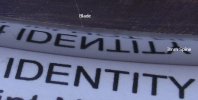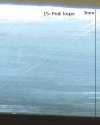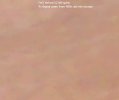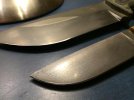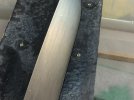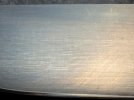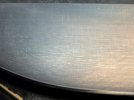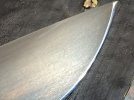I think Ed Fowler has a method by which he estimates grain size on his bevels using ferric chloride as a stain. I might have misunderstood what I read but I think this is what he does. You should be able to measure/estimate grain size using optical microscopy. i.e. 1000X should be able to discern grain sizes well below 10. Your model is untested re: grain size. You need experimental evidence to support your claims.
-
The BladeForums.com 2024 Traditional Knife is available! Price is $250 ea (shipped within CONUS).
Order here: https://www.bladeforums.com/help/2024-traditional/
You are using an out of date browser. It may not display this or other websites correctly.
You should upgrade or use an alternative browser.
You should upgrade or use an alternative browser.
Super quenched 52100 knife
- Thread starter BluntCut MetalWorks
- Start date
BluntCut MetalWorks
Knifemaker / Craftsman / Service Provider
- Joined
- Apr 28, 2012
- Messages
- 3,464
Thanks guys - I am with you on 'Extraordinary claims require extraordinary evidence'. I've shared what is quite difficult to do - super quench 52100 steel. And perhaps will share SQ result for other low Cr steels. Ifdarn internet this 52100 SQ is actually true, what's your speculation on metallurgical reasons lead to a successful SQ event? My private ht method mostly based on scientific principles+data, except fine tuning is trial&error.
Fun or not too fun read - a big benefit of fine grain: http://en.wikipedia.org/wiki/Grain_boundary_strengthening
Fun or not too fun read - a big benefit of fine grain: http://en.wikipedia.org/wiki/Grain_boundary_strengthening
Jason B.
Knifemaker / Craftsman / Service Provider
- Joined
- Jun 13, 2007
- Messages
- 11,196
Yes, ferric chloride can be used under naked eye inspection to evaluate grain size.
You need to polish the blade to a minimal of 2000 grit then using a diluted ferric chloride mixture etch the blade for about 1 minute. If he grain size is large you will see it plain as day, if the grain is fine you will have a hard time seeing anything except maybe something that resembles fine wood grain.
You need to polish the blade to a minimal of 2000 grit then using a diluted ferric chloride mixture etch the blade for about 1 minute. If he grain size is large you will see it plain as day, if the grain is fine you will have a hard time seeing anything except maybe something that resembles fine wood grain.
BluntCut MetalWorks
Knifemaker / Craftsman / Service Provider
- Joined
- Apr 28, 2012
- Messages
- 3,464
Jason B.
Knifemaker / Craftsman / Service Provider
- Joined
- Jun 13, 2007
- Messages
- 11,196
- Joined
- Jun 4, 2010
- Messages
- 6,642
You might be able to see it here.
View attachment 437863
The BRKT on the bottom has a VARY large grain structure and almost has a Damascus pattern while the ESEE looks very smooth and I was only able to see the very fine structure near the heel of the blade on one side (unable to be seen in this picture).
Thanks for sharing - this is the first time I've seen it explained so clearly in terms of finish to the naked eye.
Martin
BluntCut MetalWorks
Knifemaker / Craftsman / Service Provider
- Joined
- Apr 28, 2012
- Messages
- 3,464
Thanks Jason/Knifenut1013 for the grain pic.
Oh well, I tried for cheap grain shots but look like I need higher grit polish & etch better + better microscope (yeah like the one Martin/HH has access to). These SQ 52100 knives can easily take 10* inclusive dry-shave edge, so I think grain likely too small to be seen with naked eye or loupe.
Oh well, I tried for cheap grain shots but look like I need higher grit polish & etch better + better microscope (yeah like the one Martin/HH has access to). These SQ 52100 knives can easily take 10* inclusive dry-shave edge, so I think grain likely too small to be seen with naked eye or loupe.
- Joined
- Mar 7, 2001
- Messages
- 4,608
Thanks Jason/Knifenut1013 for the grain pic.
Oh well, I tried for cheap grain shots but look like I need higher grit polish & etch better + better microscope (yeah like the one Martin/HH has access to). These SQ 52100 knives can easily take 10* inclusive dry-shave edge, so I think grain likely too small to be seen with naked eye or loupe.
Is it finer than your previous one used in 12 steel test? Dry shave 10* edge is very tempting
:facepalm: why didn't I think of looking up wiki on this?
You might be able to see it here.
View attachment 437863
The BRKT on the bottom has a VARY large grain structure and almost has a Damascus pattern while the ESEE looks very smooth and I was only able to see the very fine structure near the heel of the blade on one side (unable to be seen in this picture).
Jason,
Will the bottom one (if the steel is carbon) when patina formed, follow the grain boundaries pattern?
Thanks for sharing this. I understand better now
Jason B.
Knifemaker / Craftsman / Service Provider
- Joined
- Jun 13, 2007
- Messages
- 11,196
Chris "Anagarika";13506386 said:Is it finer than your previous one used in 12 steel test? Dry shave 10* edge is very tempting
:facepalm: why didn't I think of looking up wiki on this?
Jason,
Will the bottom one (if the steel is carbon) when patina formed, follow the grain boundaries pattern?
Thanks for sharing this. I understand better now.
Yes, the etch expose grain boundaries and carbides, the later needing a microscope to see.
BluntCut MetalWorks
Knifemaker / Craftsman / Service Provider
- Joined
- Apr 28, 2012
- Messages
- 3,464
I just rough grinded the blade in super quenching video above. This 4" knife tempered at 430F and has 6.9* inclusive zero-grind edge, it whittled pine just fine but against dry oak the edge deformed.

Afterward, I put a tiny 20* inclusive cutting bevel, so far no problem with light whittling dry oak & other hardwood. I can see the 0.005" thick behind-the-edge flex while in use.
Edit: Jason, thanks for etched pics of Bravo knife. Those pattern look like D2 carbide orange-peel?? I could be mistaken but many grain pics show grain size mostly homogeneous and usually much smaller than 10um. If that blade with grain that big (20-100um), it probably will break like glass.

Afterward, I put a tiny 20* inclusive cutting bevel, so far no problem with light whittling dry oak & other hardwood. I can see the 0.005" thick behind-the-edge flex while in use.
Edit: Jason, thanks for etched pics of Bravo knife. Those pattern look like D2 carbide orange-peel?? I could be mistaken but many grain pics show grain size mostly homogeneous and usually much smaller than 10um. If that blade with grain that big (20-100um), it probably will break like glass.
Last edited:
Jason B.
Knifemaker / Craftsman / Service Provider
- Joined
- Jun 13, 2007
- Messages
- 11,196
It's A2 tool steel and has been beat to the point you would think breakage would be certain yet it shrugs off all abuse and keeps trucking. It's chopped down trees and batoned a cord of fire wood because we couldn't find our axe. It's take years of use and has no sign of stopping.
I have no other explanation but that it is the grain structure as you can see the vertical grind lines behind the etch.
I have no other explanation but that it is the grain structure as you can see the vertical grind lines behind the etch.
BluntCut MetalWorks
Knifemaker / Craftsman / Service Provider
- Joined
- Apr 28, 2012
- Messages
- 3,464
Here is a 1000x mag pic of A2 grain & carbide. Those CrC carbide size are around 25 to 200nm. Infer grain size around 2-5um.

Jason, your images show grain in the hundreds microns. Visible boundary lines look like, elements segregation bands - to me.
Edit:
Grain of steel similar to 80CRV2 composition. Here is the martensite matrix pic. grain looks quite coarse in 10-15um.
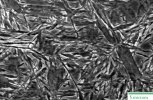

Jason, your images show grain in the hundreds microns. Visible boundary lines look like, elements segregation bands - to me.
Edit:
Grain of steel similar to 80CRV2 composition. Here is the martensite matrix pic. grain looks quite coarse in 10-15um.

Last edited:
What you are seeing in the BRKT blades is not the grains of the steel, unless the heat treatment was just eff'd. If those were the actual grains, they'd be somewhere between a grains size of 3 and -1, and you should send that knife back. You may be seeing the mechanical fibering of the steel from rolling, which is sometimes visible with a good polish and FeCl etch, and is often referred to as "grain". For reasons of clarity I prefer mechanical fibering to describe that. I've not seen any reference to FeCl as a grain boundary etchant, even with magnification. The usual etchant for things like bluntcut's picture above is nital. Estimating grain size from a picture with no scale on it is risky. Do you know the treatment for that piece of A2 BC?
BluntCut MetalWorks
Knifemaker / Craftsman / Service Provider
- Joined
- Apr 28, 2012
- Messages
- 3,464
Me2 - I got the pic from here: http://hocktools.wordpress.com/2010/06/19/o1-v-a2-one-more-time/. Author referred to those carbides as large CrC.
Unless they're doing something unusual to their A2, it would be rare for any grains to be that small (2-5 um). A2's usual range is more around 15-25 um. They could well be doing something very unusual though, like salt austenizing, induction hardening, multiple quenches, etc. Hardenability might become an issue on an air hardening steel with grains that small, though for thicknesses like chisels it might not.
Jason B.
Knifemaker / Craftsman / Service Provider
- Joined
- Jun 13, 2007
- Messages
- 11,196
What you are seeing in the BRKT blades is not the grains of the steel, unless the heat treatment was just eff'd. If those were the actual grains, they'd be somewhere between a grains size of 3 and -1, and you should send that knife back. You may be seeing the mechanical fibering of the steel from rolling, which is sometimes visible with a good polish and FeCl etch, and is often referred to as "grain". For reasons of clarity I prefer mechanical fibering to describe that. I've not seen any reference to FeCl as a grain boundary etchant, even with magnification. The usual etchant for things like bluntcut's picture above is nital. Estimating grain size from a picture with no scale on it is risky. Do you know the treatment for that piece of A2 BC?
I find reference to mechanical fibering but would like to understand this new term more. The pattern is consistent on a single sample but different among steels so my original thought was steel grain.
It looks so much like the grain structure I would have keep on thinking it was, thanks for the correction.
Its basically a term for grain flow from rolling or forging, though grain flow could be applied to the reshaping of the actual grains during cold rolling or cold forging belowthe recrystalization temperature. I've only found the term in one of my references, but it avoids the multiple meanings of "grain" and will hopefully eliminate some confusion.
Jason B.
Knifemaker / Craftsman / Service Provider
- Joined
- Jun 13, 2007
- Messages
- 11,196
I am reading similar here http://books.google.com/books?id=jN...a=X&ei=JsxpU532D_StsQTnzoGoDQ&ved=0CCYQ6AEwAQ
And some more here
http://books.google.com/books?id=AO...a=X&ei=29BpU5ndEKzisATQpoKgCg&ved=0CCoQ6AEwAA
But from what I am reading it's more about describing a failure when the steel is bent against its grain or when a steel is stressed against its grain that would cause failure in the structure. When the failure occurs they refer to it's as the fibers separating.
So basically mechanical fibers are the inclusions around rows of grain structures?
And some more here
http://books.google.com/books?id=AO...a=X&ei=29BpU5ndEKzisATQpoKgCg&ved=0CCoQ6AEwAA
But from what I am reading it's more about describing a failure when the steel is bent against its grain or when a steel is stressed against its grain that would cause failure in the structure. When the failure occurs they refer to it's as the fibers separating.
So basically mechanical fibers are the inclusions around rows of grain structures?

